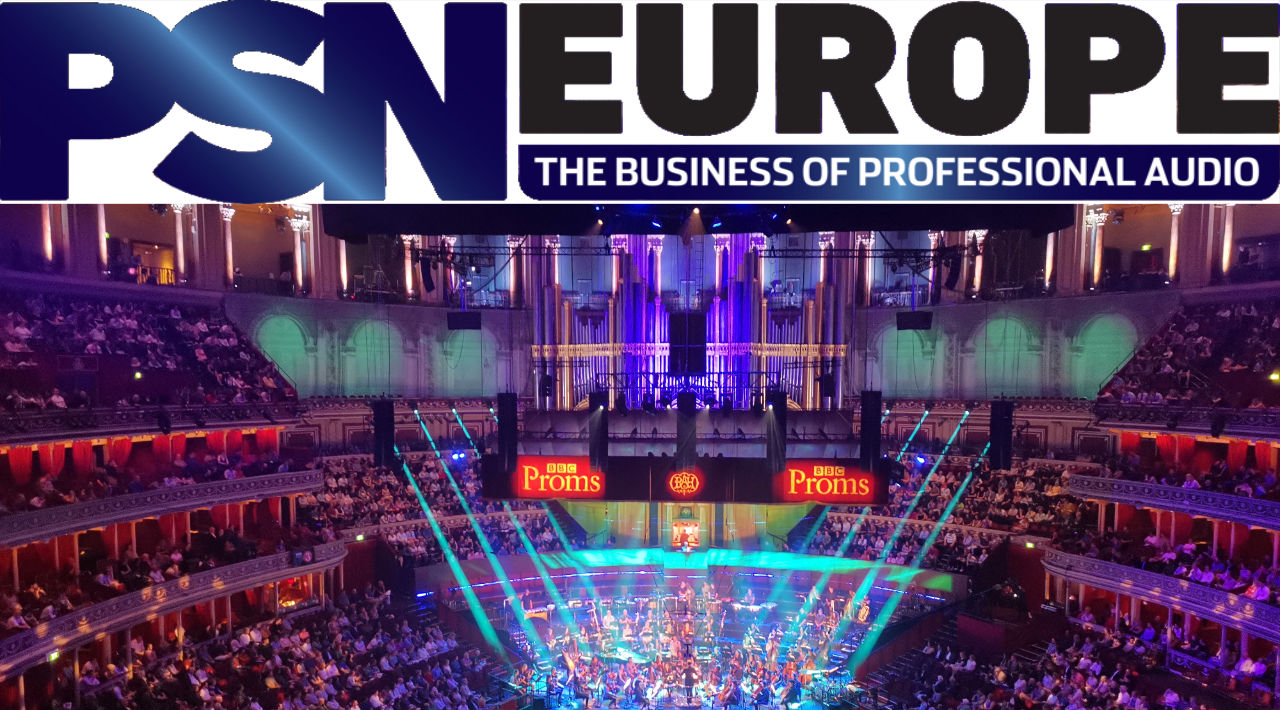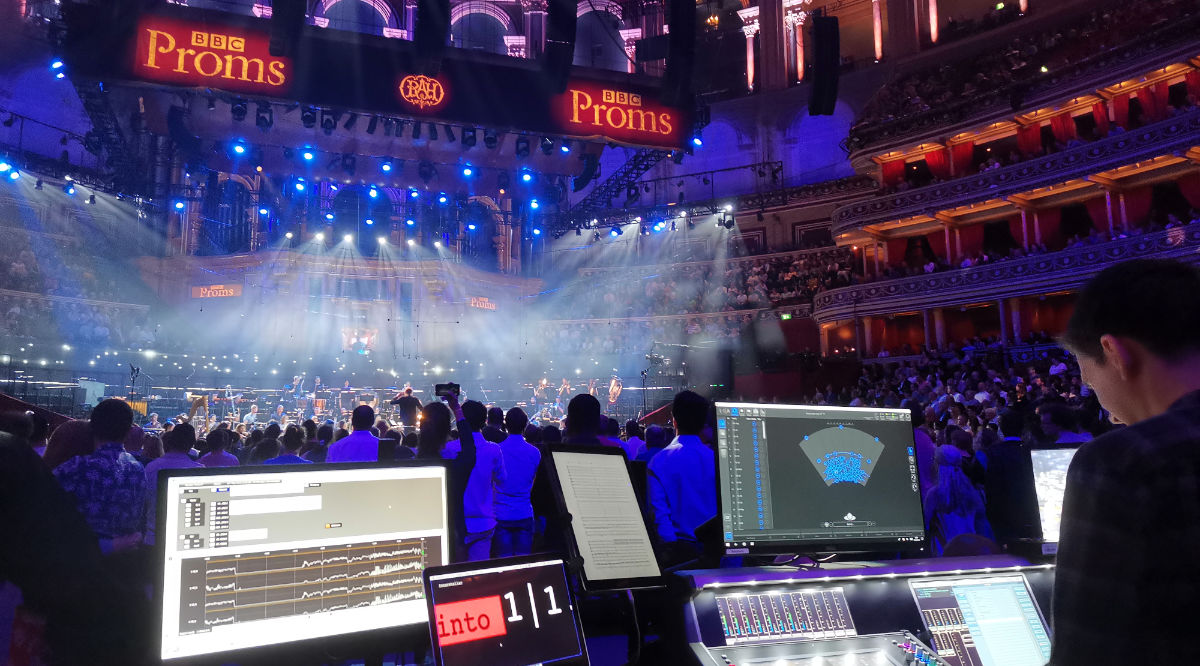The Sound of the Proms
With its frenetic schedule and hugely varied ensembles, the iconic classical music festival makes seamless collaboration between the audio teams obligatory, writes David Davies for PSN Europe
Even with such a prestigious history to reflect upon, the 2019 edition of the BBC Proms looks certain to be one to remember. Not only did it play host to a characteristically dazzling programme – from Sir Simon Rattle conducting the London Symphony Orchestra and a 300-strong choir in a performance of William Walton’s Belshazzar’s Feast, to Jules Buckley and the Metropole Orkest presiding over an elaborate tribute to Nina Simone – it also marked the 150th anniversary of the birth of its inspirational founder/conductor, Sir Henry Wood.
Following the structure established many years ago, the radio audio was again overseen by BBC Radio. Audio for the 25 (out of 75) televised Proms was delivered by The Sound Alliance, whilst live sound in the primary host venue, London’s Royal Albert Hall, and elsewhere, was masterminded by DeltaLive.
Back-to-back events and a calendar densely packed with rehearsals mean that effective scheduling and cooperation are vital. Fortunately, as DeltaLive account director Stephen Hughes observes, “there is a constant dialogue between the sound teams – we all talk all of the time and attend the same meetings. Given the complexity of the Proms, it really wouldn’t work if there were any kind of ego trips involved…”
‘Bespoke television sound’
Co-owner of The Sound Alliance with Matthew Charles, Andy Payne is a stalwart of the Proms’ TV production. Having worked on the event as a BBC employee for many years, he and Charles established The Sound Alliance in 2014 when the broadcaster decided to sell off a large chunk of its OB operations. Basing their business around a former BBC OB truck known as Master Sound, they have subsequently established a significant presence in UK music TV production, undertaking a huge amount of “BBC-centric work” including the Proms and Glastonbury, as well as projects for the likes of Sky Arts and Scottish Opera.
Payne, who estimates that he mixed TV audio for about 60 per cent of this year’s Proms, says that there are “now two key aspects to providing a bespoke television sound balance. The first of those is that the television delivery for HD is in 5.1, as opposed to regular stereo. This means that viewers with a multichannel set-up will be able to enjoy the full effect, while those with a soundbar will also have the feeling of the sound enveloping them. But whilst it’s all very well producing a lovely surround mix, delivery to the home means the 5.1 Dolby stream has to be mixed down into stereo as most consumers are still experiencing it that way. The mixdown that happens in the set-top-box or TV itself has to result in a stereo mix that has proper integrity.”
The other primary requirement is a growing recognition of the “aesthetic difference” that exists between expectations of the radio and TV sound. “To a greater extent, you need to reflect what is being seen by the cameras,” says Payne. “For example, you might have a camera close-up of an oboe solo or another individual instrument. There’s not much point doing that if the solo itself cannot be heard clearly. The sound has to sit in comfortable relation to the shot, hence the TV balance tends to be different to a regular, straight music balance.”
The current 5.1 microphone array configuration comprises Schoeps microphones and was arrived at “after a lengthy period of testing out different solutions. The nature of the ensembles we have to deal with ranges considerably, from a huge symphony orchestra with a 300-piece choir to a small chamber group. To allow for this and the fact that it’s impractical to relocate microphones once the season is up and running, three alternative array options are rigged.”
Indeed, the hugely varied nature of the Proms means that it is very difficult to talk about a ‘normal day’ in the life of the TV audio team. At the time of his conversation with PSNEurope, the memory of the Rattle/LSO Walton Prom was fresh in the mind. “We were looking at about 80 microphones in play, including about 20 suspended over the choir and the organ,” says Payne. But it was not the most technically demanding event of the year, with the Buckley/Metropole Orkest Nina Simone Prom – which involved numerous guest performers – requiring the team to mastermind “about 130 sources… it was a very big production”.
As well as Schoeps, DPA and Sennheiser microphones play an important role in the current Sound Alliance Proms inventory. The company can also share BBC Radio microphone feeds via MADI – “and sometimes they use our microphones too”. The TV audio is mixed on the Stagetec CANTUS console in the Master Sound mobile, although Payne anticipates that the vintage desk will be upgraded to an AURUS in the near-future.
Summing up some of the unique challenges of working on the Proms, Payne remarks that “every event is really a production in itself. The basic outline for a concert may be there weeks or months before, but it may only come together in the days preceding the event. It often means there are changes right up to the last minute so you have to be very responsive, but [working on the Proms] is a hugely rewarding experience.”
‘Enhancing the authenticity’
With its responsibility to deliver all of the live audio in the hall for the BBC Proms, DeltaLive has a unique and ongoing challenge to negotiate given the classical music world’s fraught relationship to amplification. “The Proms audience is very discerning and has high expectations,” says Hughes. “Also, amplification is antithetical to some concerts, while to some extent it could be said that the conductor is the sound engineer and it’s their job to know if the woodwinds are loud enough.”
Hence, the primary duty of the DeltaLive team for the 30-40 Proms each season that “require some level of amplification – be it spot amplification [for soloists] or to give certain sections a lift – is to enhance the authenticity of what is being performed on stage.”
As sound technology has evolved, so has its ability to convey the natural characteristics of acoustic instruments – and, increasingly, their spatial relationship to the room and its audience. This is revealed in the recent adoption for the Proms season of an L-Acoustics L-ISA Immersive Hyperreal Sound system, which this year comprise a flown PA system of five 15 KARA scene arrays, two 12 KARA extension arrays and four KS28 subs; flown outfills of four KARA and eight KIVA-II per side; choir fills of five KARA per side; and frontfills of four X8, 2 X12 and 4 SB18 subs.
Hughes is effusive about the L-Acoustics system, observing that it possesses a “great ability to give a very real ‘naturalness’, which makes it ideal for classical music. In fact, we recently had a rehearsal in which a few people asked about the PA, but when it was turned off they were stunned because they had not realised anything was being amplified. One of the great benefits of the L-ISA system is that it allows you to configure the system in a way that preserves the sense of what you are hearing in the hall.”
Monitors are also drawn from the L-Acoustics range, namely X12s, X8s and 5XTs. Mix world is dominated by DiGiCo equipment, with an SD5 handling FOH and an SD5/10/7 provided for monitoring. Microphones are made up of a variety of brands such as DPA, Neumann, Schoeps, AKG and Shure, while Shure Axient is the chosen radio mic system.
Like Payne, Hughes emphasises the quick turnarounds that are part and parcel of the Proms. In the space of one afternoon it’s by no means uncommon to “be rehearsing for one Prom in RAH whilst doing an afternoon event at the [nearby] Royal College of Music, along with an educational session. It’s a huge logistical exercise in terms of the equipment, as well as creating and being able to manage the sound design for all the Proms in advance and making sure you are ready every time. And there are always last minute challenges.”
But there are also many, many moments of wonder that suggest it is one of the sweetest gigs in the
music world. “The Scott Walker Prom in 2017 with Jules Buckley and the Heritage Orchestra is one that immediately springs to mind,” says Hughes. “I went into the production not really knowing Scott’s work at all, but pretty soon I had fallen in love with his music and I now regard the concert as one of the highlights of my mixing career. Hearing Susanne Sundfør perform ‘The Amorous Humphrey Plugg’ was a particular highlight, but it was phenomenal all-round. Every year there are those moments where it strikes you that this is some of the most incredible music you can find, brilliantly performed and put together.”
Article written by David Davis for PSN Europe


